Cate Parke's Blog, page 5
April 21, 2014
My Writing Process
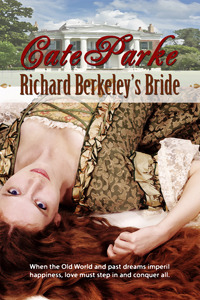 Believe me, I didn't know I had so much to say on this topic!
Believe me, I didn't know I had so much to say on this topic!Why I Write What I Do
My wonderful friend, critique partner par excellence, and Golden Heart finalist, Dawn Marie Hamilton , author of the exciting new book, Sea Panther and The Highlands Garden series, asked me to participate in a blog tour about our writing processes. Perhaps you might enjoy learning a little about why I write what I do.
What Am I Currently Working On?
My current project is called Patriot’s Dreams, the third (and last) book in my Dreams of Oakhurst series. It is the story of my two main characters who struggle to keep their home intact and their burning love alive through the long separations compelled by the long and bloody Revolutionary War in South Carolina’s back country. Richard is a Continental cavalry officer while Alexandra plays a difficult role of her own. It is to convince the British and Charlestowne's Tory elite that she and her husband sympathize with their cause. She plays a dangerous game. Who is her real adversary: Lord Cornwallis--or somebody else? Will she win or lose? She and Richard are determined it will be neither of them.
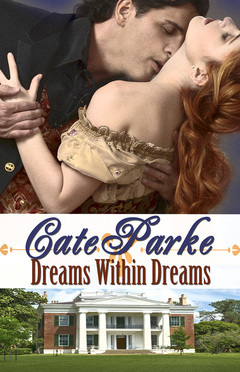 How does my work differ from others of its genre?
How does my work differ from others of its genre?My books are set in pre-Revolutionary War, Charleston, South Carolina. The final book in the series, Patriot’s Dreams, is actually set during the Revolution. The war, as it was fought in the South, is largely unknown. Most Americans have heard about Concord and the Boston Tea Party since their first years in public school. How many know, though, that it was actually won in the South?
My hero is Richard Berkeley, a scion of one of the oldest families in Charlestowne, a descendent of one of the Lords Proprietors. My heroine is the granddaughter of two dukes, the fourth Duke of Argyll and the Duke of Wessex whose ancestors were kings of England. Richard’s goal is to become one of the wealthiest, most powerful men in South Carolina. Hers is to be the son her father never had. Through Alexandra and the fabulous wealth from which she descends, Richard is set to achieve his goal. Alexandra has a little more difficulty—especially since she was raised to behave as a lady. Richard’s sister marries into the Henry family of Virginia. Remember Patrick Henry, whose classic words, “I know not what course others may take; but as for me, give me liberty or give me death!” Alexandra’s cousins marry into the highest echelons of British nobility. One of their dearest friends is General Lord Cornwallis.
I have tried to set a stage rife with possibilities for treachery and intrigue, yet remains one within which men and women can live with love and honor.
How Does My Writing Process Work?
I begin with an idea of when and where I want to set my book and then determine who my hero and heroine will be. I enjoy imagining possibilities of who these people are, what they might want, and how to make them work for what it is they hope to achieve. I try to write the story in the “house style” my publisher uses, but it’s a rough draft that I go back through, often many times and consider ways to say what it is I want my characters to say, feel, think or hear. A famous writing instructor, Margie Lawson, describes the ways we might make our characters smile, as “Miles of Smiles.” People smile when they’re happy—or when they’re trying to cover other emotions, but we can’t just say he (or she) smiled. How tedious! How did they smile—and why? Was it something someone said that evoked it? Or was it the comical way someone appeared that caused it? It’s the job of a writer to make the reader feel the character’s emotions, to despair when their character does or to laugh over a comical thought. I’ve always thought the mark of an excellent author was one who could make me cry from the force of the emotion they created. I know of some excellent authors who can do this, too. Diana Gabaldon accomplished it in her second novel, Dragonfly in Amber, and so did Renee Vincent in her magnificent novel, called Raeliksen. Màiri Norris, achieved it in her second novel, Rose of Hope. Grace Burrowes seems to manage it repeatedly. Her book, The Soldier, was the first one I read that touched me so deeply. I cried for five straight minutes with David. Such a moving story. Thank you, Grace! I hope I manage similar results in Dreams Within Dreams.
Anyway, after I’ve written what I consider golden prose, I subject my manuscript chapters to my critique partners, during which process, they’re free to rip it apart and make me humble. Thank you Dawn, Cathy-and-Derek! Afterward, my wonderful editor, Ciara Knight, makes free with it. She is a lovely lady who is, for me a Rumpelstiltskin, hardly a gnome who weaves straw into gold, but a word-genius (or genie?) instead.
The historical editor reviews it for historical accuracy and points crit partners, Ciara and I have both missed, and then the executive editor gets a final pass. It’s a long, arduous, exciting process that I feel privileged to have participated in to bring my stories to life.
I hope you’ve enjoyed reading about my writing process! Now sit back and enjoy the first scene from Dreams Within Dreams.
“Mr. Richard Berkeley and Lady Alexandra Berkeley,” proclaimed the queen’s chamberlain in stentorian tones. Sharp pounding resounded throughout the noisy chamber when he struck his long mace against the marble floor once…twice.
Heads swiveled their way. Painted and many-patched men and their ladies, garbed in gorgeous court clothes and dripping with jewels, thronged St. James Palace on this Thursday evening for the queen’s bi-weekly Drawing Room. Word of the Berkeleys’ appearance had spread through St. James District like fire through a ramshackle barn stuffed with dry hay bales. Richard’s and Alexandra’s sponsors, her grandmother and aunt, flanked them. Two duchesses as sponsors—such had never before been the case to everybody’s certain knowledge.
Richard led Alexandra forward through crowds that parted like the Red Sea before Moses when they passed down the center of the mammoth room. Halting before the pregnant queen, Richard swept his grey tricorn from his head, extended a foot and bowed from his waist while his wife sank into a deep curtsey.
Waves of murmurs swept through the assembly behind them, scarcely audible confidences, overheard by Richard’s keen ear. One of them, a girl born with every advantage, had allied herself to a mere gentleman whom nobody had ever heard of before, nobody would distinguish with an invitation anywhere, and nobody wanted to know. Yet from the number of invitations flooding in to Her Grace of Argyll’s secretary, everybody most plainly did. From the corner of Richard’s eye, he glimpsed several short men and a few women clamber onto chairs to capture a better view of them. One elderly dame even lifted a lorgnette containing pink glass to match her silk gown. Richard successfully stifled a smirk. For somebody nobody wanted to acknowledge, he’d garnered enormous attention.
“We have not enjoyed your presence in our Court for the past year and more, Lady Alexandra.”
Queen Charlotte’s gaze swept her from bright red, high-piled curls to the hem of her magnificent embroidered cloth-of-silver wedding gown, the only acceptable attire for her appearance today.
“We hear you have given birth to a son, Lady Alexandra. What did you name him?”
“Edward Thomas Rutledge Campbell Berkeley, Ma’am. He was born last December.”
“We are pleased to see you in good health, for you appear well, indeed. You give no evidence of your recent travail. And you are happy, we see, for you are aglow with it. Very well, very well,” she smiled, a rare occurrence during one of these tedious events, and waved her hand in dismissal. “Now step aside, gel, while we acquaint ourself with your gentleman.”
Richard snapped to attention and bowed his head. “Your servant, Ma’am,” he drawled. His accent, with its long, slow, in-gliding vowels brought a smile to the queen’s lips. Those near enough to witness her open appreciation gasped, their eyes widened with amazement.
The small woman before him lifted her head and gazed into his eyes. He’d come to recognize such smiles. He’d seen them since he was a boy, fighting off advances from flirtatious females.
“We are charmed by your distinctive accent, Mr. Berkeley. You are from Charlestowne of our South Carolina colony, are you not?”
“Yes, Ma’am. I am.”
“Yet you spent a number of years in England.”
“That’s true, Ma’am,” he grinned, impressed she knew anything of him. Of course, Alexandra had written her and, doubtless, explained. “I attended school in England. Lord Edward Campbell convinced my father to send me to Eton when I was eight years old. Later, I entered his alma mater, Christ Church, Oxford. Afterward, I trained in the law at London’s Middle Temple.”
“Is that when you met Lady Alexandra?”
“No, Ma’am. I didn’t have that privilege until several years later.”
From the corner of his eye, he glimpsed Alexandra slanting a glance at him while he stood at ease, with hands folded behind his back, and flashed a grin at the queen. The small brown-haired, sallow-skinned woman with striking turquoise eyes lifted her chin. He suspected nobody ever presumed to grin at her. But Her Majesty was a woman and, he supposed, from her widened eyes and the flirty grin playing on her lips, he’d surprised and stricken her, as he had most women all his life.
“How was that, Mr. Berkeley?”
“Lord Edward Campbell, Lady Alexandra’s father, was my mentor and, later, my business partner, Ma’am. He and my father planned a betrothal between us since we were children—though, they didn’t bother to share the information with either of us until the spring of 1768. Since I was soon to embark upon a voyage to England, His Lordship sent along a letter of introduction to the Duke of Argyll, in Inveraray, Scotland. After I saw to my affairs in London, I travelled north—and met my wife.”
“I see. Yet, Lady Alexandra failed to mention it to us during the following year when she served us as a Maid of Honor.”
Richard grinned again, amused. Her Majesty gasped and leaned toward him, her eyes widened further. He doubted any gentleman had ever been so audacious as to display genuine friendliness toward Her Majesty during all the years she’d sat beside her husband on his throne.
“A delicious tale, Mr. Berkeley. We have always been fond of your lady wife, and are pleased you make her happy.”
“I’ve tried, Your Majesty, but I’ve not always succeeded.”
“And why is that, sir?” By her alert posture and the crinkling of her eyes at the corner, Richard knew laughter lurked while she awaited the outcome of his anecdote.
“You see, once I refused to burn a house down for her. On another occasion, I forbade her to ride. I recall even threatening to post guards on her. She was remarkably unhappy with me on both occasions, Ma’am.”
“And why were you commanded to burn a house down, Mr. Berkeley?”
“It contained a nest of snakes, Ma’am.”
The queen’s eyes flew wide and she glanced toward Alexandra. “A nest of vipers, Mr. Berkeley? Pray share the tale with us.”
“Well, you see, I’d bought a sawmill upriver from our home. After cleaning and repairing homes for the workers I’d hired, my wife pulled aside a bed, and there they were. Believe me, Ma’am, I’ve never heard such blood-curdling screams.”
“We should say not! What did you do?”
“Well, I carried my wife outside before she strangled me, while others carried out the snakes. Once they were gone and the place was cleaned, there was no longer a need to burn down the house.”
“She nearly strangled you, you say?”
“Yes, Ma’am. She jumped at me and wouldn’t let go of my neck. It felt like I’d imagine a tightening noose might feel, you see. On that same occasion she nearly suffocated herself and our child, as well.”
****
Beside him, and amused by his tale, Alexandra fidgeted, wanting to supply some detail that did not present her actions in quite such a…colorful manner. Queen Charlotte pointedly ignored her, though, and she dared not speak unless addressed by Her Majesty.
“I must hear this tale now, if you please, Mr. Berkeley,” the queen demanded.
“My wife took it upon herself to burn vermin-ridden bedding in a fireplace that didn’t work properly. Lady Alexandra was not happy with my response, I fear.”
“Indeed? What did you do?” Another of her rarely seen public smiles wreathed her face. The muscles in her cheeks and about her mouth twitched with the effort to maintain her regal composure.
“I wanted to turn her over my knee, I assure you. That might not have been appropriate, given her delicate condition, though. Instead, I snatched her into my arms, carried her outside and ordered her to sit. Without a single chair on the site, however, my only alternative was to assign her a simple task. It gave her something to do and kept her out of everyone else’s hair, at least.”
A Queen of England may never be said to roar with mirth but her laughter rang through the Presence Chamber and she clapped her hands in delight. Her ladies fluttered about her, fanning her and dabbing the tears streaking her cheeks with lacy handkerchiefs.
Finally, re-gaining control of herself, regret crossed her face. “We fear we must excuse you, Mr. Berkeley, and remember the others awaiting our notice. We look forward to meeting you again at court. Lady Alexandra, we are glad to welcome you back.”
“Thank you, Ma’am,” Alexandra replied, sinking into another curtsey, then backed away from the throne, her hand again in Richard’s.
Her Majesty had extended the usual five minutes granted to each couple by twice as long. This was to the consternation of her formidable chamberlain who stood nearby drumming his fingers on his lectern and waving his hand each time the queen glanced his way, hoping to attract her attention.
After they retreated from the throne, another couple approached who had been kept waiting. The redoubtable Lady Mary Coke, ever present at these bi-weekly affairs, sallied forth and accosted Alexandra.
Her Grandfather Argyll’s first cousin was the daughter of the great Second Duke of Argyll. Lady Mary reigned over St. James District. “You may introduce your gentleman, Lady Alexandra,” she commanded, as though nobly bestowing a great honor.
Inward rage roiled within Alexandra’s breast at the woman’s haughty demeanor toward her tall, handsome husband. Richard bowed when Alexandra introduced him. Her grandfather, the Duke of Wessex, approached and greeted Lady Mary. Afterward, he claimed Richard’s attention and took him to meet a friend. Alexandra could have murdered him for taking Richard away and leaving her alone to combat the arrogant woman. She expected nothing but censure from the fearsome dame, nor was she long disillusioned that she might escape.
Come visit my lovely friend, Lizzie Walker, next Monday, April 28th, at her terrific site, Bttrfliesz Are Free at bttrfly29.blogspot.com!
And thanks for joining me today.
Published on April 21, 2014 20:07
March 28, 2014
Writing Oddities
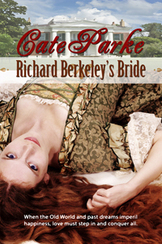 When I began writing Richard Berkeley's Bride, I knew I had some research to do, but I had no idea just how much. I'd planned to call my hero Richard Hutson, for instance. As you can see above, however, there really was a guy by that name who lived at that same time. Hm-m. Not a great plan here. So I decided to give him the name of someone who had never lived--at least as far as I can tell. He had to have a name of someone who might have, however. After very little deliberation, Richard Berkeley became his name.
When I began writing Richard Berkeley's Bride, I knew I had some research to do, but I had no idea just how much. I'd planned to call my hero Richard Hutson, for instance. As you can see above, however, there really was a guy by that name who lived at that same time. Hm-m. Not a great plan here. So I decided to give him the name of someone who had never lived--at least as far as I can tell. He had to have a name of someone who might have, however. After very little deliberation, Richard Berkeley became his name.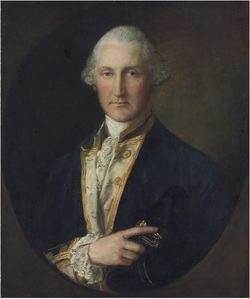 Lord William Campbell, painting by Gainesborough Ditto with my heroine's father. I initially named him Lord William Campbell. I made him the third son of the Fourth Duke of Argyll and the last Royal Governor of South Carolina. Guess what. There really was a Lord William Campbell who was the third son of the Fourth Duke of Argyll and what's even more coincidental, he was the last Royal Governor of South Carolina. How's that for coincidence?
Lord William Campbell, painting by Gainesborough Ditto with my heroine's father. I initially named him Lord William Campbell. I made him the third son of the Fourth Duke of Argyll and the last Royal Governor of South Carolina. Guess what. There really was a Lord William Campbell who was the third son of the Fourth Duke of Argyll and what's even more coincidental, he was the last Royal Governor of South Carolina. How's that for coincidence?A name change was in store. I wanted someone entirely fictional. So he became Lord Edward Campbell, the second son of the 4th Duke of Argyll. That position actually belonged to Lord Henry Campbell who died at Lauffeldt in February, 1747. But I made Lord Edward a year older--I can do that. I'm an historical romance author. I write fiction. I love it! Hahaha.
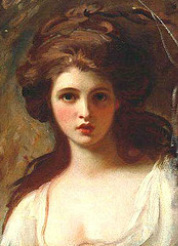 Not really Lady Louisa, but she's pretty, isn't she? Ordinarily, I like encountering coincidences. Really. Not so when I'm trying to find names for characters. When I first met my heroine, her name was Louisa. Louisa Campbell. Interesting. There really was a Louisa Campbell and she really was the daughter of Lord William Campbell. A name change was in store. I named her Julia, but try as I might, I just couldn't like the name as well as I liked Louisa. I wanted a name that could be changed and given to a man, as in Louis...or Jules...or Alexander. Hm-m. Yes--I could like Alexandra. I really could, so Alexandra became my heroine's name.
Not really Lady Louisa, but she's pretty, isn't she? Ordinarily, I like encountering coincidences. Really. Not so when I'm trying to find names for characters. When I first met my heroine, her name was Louisa. Louisa Campbell. Interesting. There really was a Louisa Campbell and she really was the daughter of Lord William Campbell. A name change was in store. I named her Julia, but try as I might, I just couldn't like the name as well as I liked Louisa. I wanted a name that could be changed and given to a man, as in Louis...or Jules...or Alexander. Hm-m. Yes--I could like Alexandra. I really could, so Alexandra became my heroine's name.
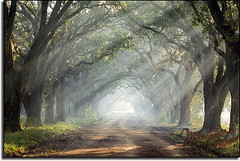 West of the Ashley Speaking of coincidence, I'd named Lord William's plantation The Oaks. Guess what? There really was a plantation named The Oaks, though it wasn't placed where I'd placed the one now belonging to Lord Edward, along the Ashley River, upriver from Middleton Place Plantation. The Oaks was never owned by Lord William. It belonged to the Izard family--the family he married into. His son William lived there at one time. True. All true. So the plantation was renamed Oakhurst...and became the setting for my three Dreams of Oakhurst novels, Richard Berkeley's Bride, Dreams Within Dreams and Patriot's Dreams. I hope you like them!
West of the Ashley Speaking of coincidence, I'd named Lord William's plantation The Oaks. Guess what? There really was a plantation named The Oaks, though it wasn't placed where I'd placed the one now belonging to Lord Edward, along the Ashley River, upriver from Middleton Place Plantation. The Oaks was never owned by Lord William. It belonged to the Izard family--the family he married into. His son William lived there at one time. True. All true. So the plantation was renamed Oakhurst...and became the setting for my three Dreams of Oakhurst novels, Richard Berkeley's Bride, Dreams Within Dreams and Patriot's Dreams. I hope you like them! 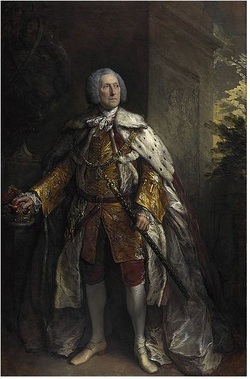 Gen. John Campbell Fourth Duke of Argyll By the way, I've told you about the Fourth Duke of Argyll. Would you like to see his picture? Of course you would! He's shown in his ducal robes here. This painting is by Thomas Gainesborough.
Gen. John Campbell Fourth Duke of Argyll By the way, I've told you about the Fourth Duke of Argyll. Would you like to see his picture? Of course you would! He's shown in his ducal robes here. This painting is by Thomas Gainesborough.
Published on March 28, 2014 11:24
February 1, 2014
Travails of Travel: Reprise--or what happened on the way to Newport
 Okay--Now I don't believe you. True love stories have no real endings…. Fortunately, the same isn’t true of travel. During my husband’s twenty-six year Navy career, we lived in North Chicago, Illinois; Vallejo, California…twice; Idaho Falls, Idaho; Newport News, Virginia; Charleston, South Carolina…twice, (with multiple moves in that city both times!); Westover Air Force Base (in Chicopee, Massachusetts); two lengthy sojourns back in Albuquerque while my husband attended Navy schools; Austin, Texas (HOOK ‘EM HORNS!); Newport, Rhode Island; Monterey, California and Arlington, Virginia. Our last move brought us to the home we built among the foothills of the Smoky Mountains in lovely Northeast Tennessee.
Okay--Now I don't believe you. True love stories have no real endings…. Fortunately, the same isn’t true of travel. During my husband’s twenty-six year Navy career, we lived in North Chicago, Illinois; Vallejo, California…twice; Idaho Falls, Idaho; Newport News, Virginia; Charleston, South Carolina…twice, (with multiple moves in that city both times!); Westover Air Force Base (in Chicopee, Massachusetts); two lengthy sojourns back in Albuquerque while my husband attended Navy schools; Austin, Texas (HOOK ‘EM HORNS!); Newport, Rhode Island; Monterey, California and Arlington, Virginia. Our last move brought us to the home we built among the foothills of the Smoky Mountains in lovely Northeast Tennessee.Oops! Forgive me—I forgot one. This weekend a friend reminded me of it. Hm-m…some friend. So I’ll resurrect these original blog posts of mine just this one time.
I speak of the memorable trip my small daughter, elderly cat and I took to Newport, Rhode Island wherein I got lost in the wilds of New Jersey. It was early January, 1980. The trip progressed well. We started out from Austin, Texas and drove up to my sister-in-law’s house in one of Dallas-Fort Worth’s center cities. That was the time my brother-in-law queried my daughter about how “cat” and “dog” are—or rather—are NOT spelled. It went something like this: “Okay, Gretchen, how is “cat” spelled?” The poor kid is a phonetic speller. And Jeff is a born and bred Texan. Her reply went something like this: “C…A…A…T.” “No,” replies her uncle with his strong Texan twang, “it’s spelled ‘c-a-t’. Okay, now, this is easy. How do you spell dog?” “D…O…O…G,” Gretchen dutifully replies. “No,” Jeff replies once again, his muscular Texas drawl doing the verbal equivalent of push-ups and pull-ups a Marine would have been proud of. “It’s spelled “d-o-g.” I let it go. More on this topic later. I’m just glad she finally learned to spell the English language.
 Blizzard So we depart DFW the next morning and make our way to I-40 without a single hitch. We pass through a blizzard as soon as we hit I-81 in the gorgeous state of Tennessee. What did Tennessee look like? I couldn’t have told you up to that point. I’d only passed through it in either a long winter’s deep dark of night, driving rain or white-out blizzard. Not auspicious introductions to the state I now call home. I digress. We finally arrived in Bristol, TN and stopped for hot chocolate—and a potty break of course. Sorry…TMI. So we soldiered on...and on...and on through driving snow.
Blizzard So we depart DFW the next morning and make our way to I-40 without a single hitch. We pass through a blizzard as soon as we hit I-81 in the gorgeous state of Tennessee. What did Tennessee look like? I couldn’t have told you up to that point. I’d only passed through it in either a long winter’s deep dark of night, driving rain or white-out blizzard. Not auspicious introductions to the state I now call home. I digress. We finally arrived in Bristol, TN and stopped for hot chocolate—and a potty break of course. Sorry…TMI. So we soldiered on...and on...and on through driving snow.
 Tappan Zee Bridge
Tappan Zee Bridge We reached Roanoke, Virginia as darkness fell with a resounding crash, found a hotel, ate supper and collapsed in our beds. Next morning, frigid air, but clear skies greeted us with a great big grin. I should have been warned—it wouldn’t last. Oh—it remained clear, sunny, too. That was all. Up I-81 to Harrisburg, PA. I continued on, dutifully following my Rand McNally map. I found I-78…no problem. But just past the state line with New Jersey, the plot thickened. I came across a sign that read something like I-78 South and I-78 North. South? Despite the fact that the car tried to turn toward the southbound lanes, instinct tells me, Rhode Island is north. Right? Wrong. Within five miles I hit village streets. Endless village streets. I’m still headed north though, by gosh and by golly! At least give me a “P.” (It stands for Persistence.) I don’t know how many miles we travelled through those tiny towns and small villages. Thousands and thousands of them, surely. The sun was going down and I was getting desperate—still without a single clue where I was. I knew I had to cross the Tappan Zee Bridge, but where was the blasted thing? It isn’t small. It crosses the Hudson River, for Pete’s sake. It’s huge. Mammoth. Get the picture? So finally, near tears, I stopped in a parking lot to peer at the map—still clueless, but persistent. A nice man left the building whereby the parking lot was located. “Can I help you, lady?” he asks pleasantly. After my pathetic admission, and he finally stops hee-hawing, he points down the street and says, “Go down three blocks then turn left for two blocks then turn right and you’ll see the bridge…or something to that effect. I clung to those directions like a drowning man clings to a life preserver. “Don’t say anything to me just now,” I ask child. “That goes for you, too,” I order the cat. Everybody stares at me with round eyes as I mutter the directions to myself over and over. I go down two blocks, turn left and go down two more, turn right and—there’s the blessed bridge. Where did it come from? It isn’t like New Jersey hid the thing behind an Invisibility Cloak. Like I said, the darned thing’s colossal.
 OLD, Old Jamestown Bridge--scary! We get through Connecticut before completely losing the light and then we’re off the freeway, following backroads in the dark. We get to a high but narrow and rickety two-lane bridge, called the Old Jamestown Bridge. No truer word was ever applied to a bridge—“Old,” that is. I laugh my idiot head off. An elderly nurse I’d worked with in Austin had gripped the car door’s armrest each time she crossed the I-35 bridge over the Colorado River with me. Maybe she knew something I didn’t, but the bridge is something like eight lanes wide, stable and absolutely flat.
OLD, Old Jamestown Bridge--scary! We get through Connecticut before completely losing the light and then we’re off the freeway, following backroads in the dark. We get to a high but narrow and rickety two-lane bridge, called the Old Jamestown Bridge. No truer word was ever applied to a bridge—“Old,” that is. I laugh my idiot head off. An elderly nurse I’d worked with in Austin had gripped the car door’s armrest each time she crossed the I-35 bridge over the Colorado River with me. Maybe she knew something I didn’t, but the bridge is something like eight lanes wide, stable and absolutely flat.Eureka! City lights ahead! Not many, granted, but any are better than the none I’m currently seeing.
 Narragansett Bay Bridge
Narragansett Bay Bridge So we cross into Newport on the wide, stable Narragansett Bay Bridge and…now what? I don’t have a clue where my husband is…don’t even have a clue where the Navy base is. It’s big, too. It’s not like they put up signs that point the way. No siree, Mama! Not the Navy. They can cross trackless seas without a road map—and presumably, so can their wives.
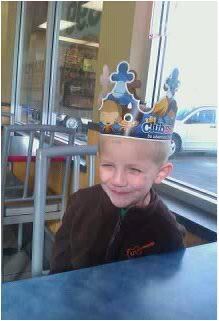 Burger King Then I see a little white sign off to the left. It said something about a “Gate.” Navy bases all have gates on them so that’s the way I head. The guard at the gate made the B-A-A-D (I didn’t learn to spell in Texas, by the way) mistake of shaking his head at me when I asked him to call my husband for me.
Burger King Then I see a little white sign off to the left. It said something about a “Gate.” Navy bases all have gates on them so that’s the way I head. The guard at the gate made the B-A-A-D (I didn’t learn to spell in Texas, by the way) mistake of shaking his head at me when I asked him to call my husband for me.Ever witness an already wild-eyed woman come completely unglued? I guess I scared him because he grabbed his phone pronto. My wonderful husband tells me to meet him at the Burger King in ten minutes. (I have a six-year-old with me and they all like those cute paper crowns, right?) "Just one question. Where’s the Burger King?" It’s not like I know this place. It isn’t like I couldn’t get lost on an island. I just got over being lost in New Jersey, for God’s sake!
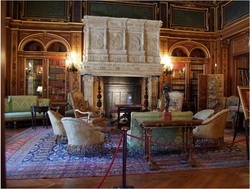 The Breakers, Newport RI, Library--NOT our house! So I get the directions, followed ‘em, and there we were. Easy, peasy. Husband arrives, happy as a clam. We ate, husband asks questions like, “What’s wrong with you?” Then laughs like a wild monkey when I tell him my tale. Brave man. He clearly doesn’t know who he’s messing with here—doesn’t have a clue of the danger he’s in. My blue eyes start flashing and the whites turn red to match my red hair. I morph into an honest-to-God fire-breathing dragon—I meant wife. He’s a fearless U.S. Navy officer, but understands retreat is sometimes the better part of valor. He changes the subject fast. Tells me all about the gatehouse full of antiques he’s rented for our winter stay in the city. Sounds fun. But if antiques amount to old and ugly, then those furnishings fit the bill. But I’m a Navy wife—I can make anyplace feel like home.
The Breakers, Newport RI, Library--NOT our house! So I get the directions, followed ‘em, and there we were. Easy, peasy. Husband arrives, happy as a clam. We ate, husband asks questions like, “What’s wrong with you?” Then laughs like a wild monkey when I tell him my tale. Brave man. He clearly doesn’t know who he’s messing with here—doesn’t have a clue of the danger he’s in. My blue eyes start flashing and the whites turn red to match my red hair. I morph into an honest-to-God fire-breathing dragon—I meant wife. He’s a fearless U.S. Navy officer, but understands retreat is sometimes the better part of valor. He changes the subject fast. Tells me all about the gatehouse full of antiques he’s rented for our winter stay in the city. Sounds fun. But if antiques amount to old and ugly, then those furnishings fit the bill. But I’m a Navy wife—I can make anyplace feel like home.I have fond memories of the place after all these years. Except for starting my child in school on a Friday. What idiot does that? Don’t ask. My poor phonetic speller came home with a spelling test she’d all but failed. From the list previously mentioned daughter brought home, the first-grade teacher had a New England accent. A strong one. I had not yet met her and I already knew it.
 The Marble House, Newport, RI--Not our house either.
The Marble House, Newport, RI--Not our house either.
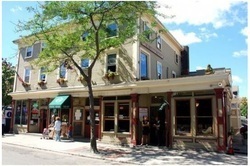 Sala's Restaurant, Newport, RI Do you know that, during early January, it gets dark in Newport by 4:30 p.m.? Me either. Except for a six month stint in central Massachusetts, from late November through late March, 1976, I’d always managed to live south of the Mason-Dixon. My husband was supposed to take us out for supper our first night in Newport. He got home late that evening. Gretchen was ready to eat the cat by the time he showed up. He took us to this really great restaurant right on the waterfront called Sala’s. Daughter ordered her favorite food, spaghetti and husband made it a quarter serving. “She’s hungry,” I warn. “Trust me,” says he. He’s right. A quarter serving filled a platter. And I had a whole lobster—fresh from the ocean—right on the platter before me. Life is good.
Sala's Restaurant, Newport, RI Do you know that, during early January, it gets dark in Newport by 4:30 p.m.? Me either. Except for a six month stint in central Massachusetts, from late November through late March, 1976, I’d always managed to live south of the Mason-Dixon. My husband was supposed to take us out for supper our first night in Newport. He got home late that evening. Gretchen was ready to eat the cat by the time he showed up. He took us to this really great restaurant right on the waterfront called Sala’s. Daughter ordered her favorite food, spaghetti and husband made it a quarter serving. “She’s hungry,” I warn. “Trust me,” says he. He’s right. A quarter serving filled a platter. And I had a whole lobster—fresh from the ocean—right on the platter before me. Life is good.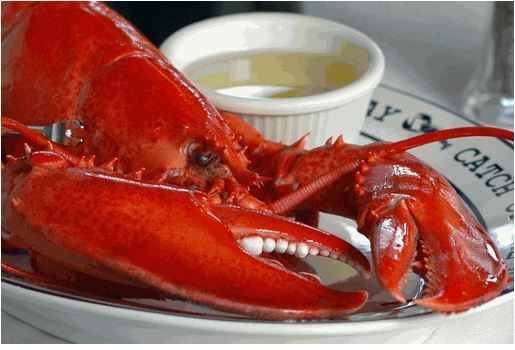
Published on February 01, 2014 08:48
December 16, 2013
Merry Christmas...or ¡Feliz Navidad!
 Albuquerque at Sunset Of Piñon, Red Chile Ristras, Farolitos and…Home
Albuquerque at Sunset Of Piñon, Red Chile Ristras, Farolitos and…HomeChristmas in New Mexico
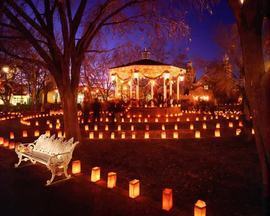 Christmas in New Mexico begins earlier than is usual in most other American locales, on December 16th, with Las Posadas (LAS poh-SAH-dahs, Spanish for "the inns"). It’s a nine-day children’s festival that ends on Christmas Eve. For centuries, Las Posadas has been an honored part of the Christmas tradition. In it, families, churches, communities and, in Santa Fe's case, the Palace of the Governors, re-enact the search by Mary and Joseph to find lodgings prior to the birth of Jesus. A typical Las Posadas celebration stretches out over nine nights, from Dec. 16th to the 24th—with different families hosting a small party for the children and others in their homes.
Christmas in New Mexico begins earlier than is usual in most other American locales, on December 16th, with Las Posadas (LAS poh-SAH-dahs, Spanish for "the inns"). It’s a nine-day children’s festival that ends on Christmas Eve. For centuries, Las Posadas has been an honored part of the Christmas tradition. In it, families, churches, communities and, in Santa Fe's case, the Palace of the Governors, re-enact the search by Mary and Joseph to find lodgings prior to the birth of Jesus. A typical Las Posadas celebration stretches out over nine nights, from Dec. 16th to the 24th—with different families hosting a small party for the children and others in their homes.The tradition of Las Posadas dates back to the 16th century and St. Ignatius Loyola, who used an Aztec festival to teach about the birth of Christ, turning their nine-day celebration of the birth of the Aztec Sun God into a Christian celebration. What started as a novena, or nine days of prayer, eventually moved from the church to the community, to be celebrated in people's homes.
Typically, each family in a village or a neighborhood will schedule a night for the Posada to be held at their home. Every home has a nativity scene and the hosts of the Posada act as the innkeeper. The neighborhood children and adults are the pilgrims (peregrinos), who have to request lodging by going house-to-house singing a traditional song about the pilgrims. All the pilgrims carry small lit candles, or farolitos, in their hands. Two children portray Joseph and Mary. In many cases, Mary rides a small donkey (or burro) and Joseph leads it. Attendants such as angels and shepherds are acquired along the way, and walk along behind Mary and Joseph. The head of the procession will have a candle inside a paper lampshade. At each house, the resident responds by refusing lodging (also in song), until the weary travelers reach the designated site for the party, where Mary and Joseph are finally recognized and allowed to enter. At the end of the long journey, there will be Christmas carols (villancicos), and children will break open piñatas by striking these colorful papier-mâché objects with bats while blindfolded to break them open and obtain the candy hidden inside. Afterward comes the holiday feasting.
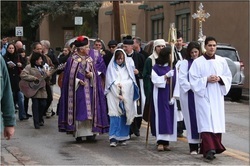 The Las Posadas procession from St. Francis de Assisi Cathedral
The Las Posadas procession from St. Francis de Assisi Cathedral
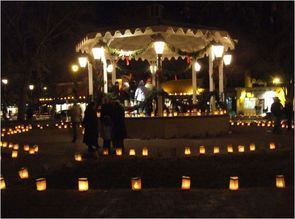 In northern New Mexico, farolitos (or little lanterns) help to light the way for Las Posadas and, on Christmas Eve, they will line the walkways and rooftops of homes and businesses in the millions, creating a candlelit wonderland, to light the way of Santo Niño to the church on the plaza. People in Albuquerque call the paper bag lanterns, luminarias, but natives from Santa Fe and the villages of Northern New Mexico insist the correct term is farolitos. Historically, a true luminaria is one of a series of small bonfires lining the roads.
In northern New Mexico, farolitos (or little lanterns) help to light the way for Las Posadas and, on Christmas Eve, they will line the walkways and rooftops of homes and businesses in the millions, creating a candlelit wonderland, to light the way of Santo Niño to the church on the plaza. People in Albuquerque call the paper bag lanterns, luminarias, but natives from Santa Fe and the villages of Northern New Mexico insist the correct term is farolitos. Historically, a true luminaria is one of a series of small bonfires lining the roads.On Christmas Eve, as darkness fell at my home in Albuquerque, the luminarias were set alight to burn all night long. My father built a massive adobe fireplace, centered against the longest wall in the family room. A popping, flickering piñon fire cast its warm fragrant scent into the air. The blue spruce Christmas tree, my dad cut in the high country of northern New Mexico was decorated with black or brown-centered ojos de dios—the eyes of God—to watch over our home and family. Small kachinas, made from bits of felt and stuffed with cotton, hung from the trees as did the odds and ends made by my brothers and me over the years, in school, Cub Scouts and Girl Scouts. Mother also decorated the tree with iced sugar cookies, tied up in cellophane with colorful ribbon, and candy canes. It was an eclectic sort of tree, a tree celebrating children, but it was…beautiful...magical. Later on, after all of us were grown, mother decorated native plants to use as their Christmas tree. An artist, each tree Mother decorated was original, unique and remembered now only in pictures by a grateful daughter who treasured them and the memories she helped create.
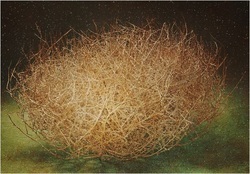 Tumbleweed...in case you wondered. My dad usually supplied the Christmas trees for our classrooms but, when I was in fifth grade, we made something quite different. We put white powdered tempera paint into big brown paper sacks along with wet tumbleweeds. We shook them gently, a hard task for a fifth-grader! Tumbleweeds abound on the high desert, so we never had far to look for another if the last one we’d just made had shaken a little too hard inside the paper sack. Once removed from the sack and dried, we hung small red glass balls on them, stacked them in roughly the shape of a Christmas tree. We suspended some of our white-painted tumbleweeds from the classroom ceiling. They might look tacky to adult eyes and might have been a terrible fire hazard. But to a fifth grade child eager to see what came on Christmas Day, they were way cool.
Tumbleweed...in case you wondered. My dad usually supplied the Christmas trees for our classrooms but, when I was in fifth grade, we made something quite different. We put white powdered tempera paint into big brown paper sacks along with wet tumbleweeds. We shook them gently, a hard task for a fifth-grader! Tumbleweeds abound on the high desert, so we never had far to look for another if the last one we’d just made had shaken a little too hard inside the paper sack. Once removed from the sack and dried, we hung small red glass balls on them, stacked them in roughly the shape of a Christmas tree. We suspended some of our white-painted tumbleweeds from the classroom ceiling. They might look tacky to adult eyes and might have been a terrible fire hazard. But to a fifth grade child eager to see what came on Christmas Day, they were way cool. Christmas Eve was never complete without dinner at La Placita, a Mexican restaurant on the Plaza. In the lobby, the blue spruce Christmas tree, flocked white to resemble it as it was before it was cut out of snowy woods, was decorated with little white lights to resemble starry New Mexico nights and hung with red chiles tied to the trees with green ribbon. In the dining room, a cottonwood tree grew right through the roof. Hostesses supplied us with baskets piled high with fresh, hot, puffy sopapillas and jugs of honey. You eat them by biting off a corner, filling it with honey that drips down your chin and onto your fingers as you eat it. They also took away a little of the sting from the fiery hot red chile salsa that the fresh hot blue and yellow corn tortilla chips had been dipped in. (In New Mexico, if you’re asked red or green, they’re referring to the chile—and they don’t mean con carne!) Soon the table was laden with posole for good luck, tamales, enchiladas made with fresh hot tortillas, Mexican rice and frijoles refritos…yum, yum!
Christmas Eve was never complete without dinner at La Placita, a Mexican restaurant on the Plaza. In the lobby, the blue spruce Christmas tree, flocked white to resemble it as it was before it was cut out of snowy woods, was decorated with little white lights to resemble starry New Mexico nights and hung with red chiles tied to the trees with green ribbon. In the dining room, a cottonwood tree grew right through the roof. Hostesses supplied us with baskets piled high with fresh, hot, puffy sopapillas and jugs of honey. You eat them by biting off a corner, filling it with honey that drips down your chin and onto your fingers as you eat it. They also took away a little of the sting from the fiery hot red chile salsa that the fresh hot blue and yellow corn tortilla chips had been dipped in. (In New Mexico, if you’re asked red or green, they’re referring to the chile—and they don’t mean con carne!) Soon the table was laden with posole for good luck, tamales, enchiladas made with fresh hot tortillas, Mexican rice and frijoles refritos…yum, yum!I’ll be home for Christmas, Mom, if only in my dreams…
Published on December 16, 2013 10:24
October 31, 2013
It's Samhain! That's Halloween if you prefer.
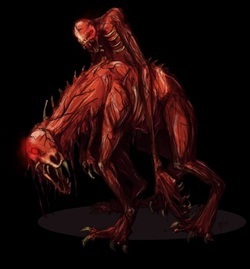 Nuckelavee I thought you would enjoy a little excerpt from Richard Berkeley's Bride...and a little tale of Samhain. Are you ready? Of course you are!
Nuckelavee I thought you would enjoy a little excerpt from Richard Berkeley's Bride...and a little tale of Samhain. Are you ready? Of course you are! Ten nights before their wedding, Richard took Alexandra for a walk on the verandah. Here is what happened....
She was unsure what to do or say. Heat stung her neck and face once more but, far from cold, her skin burned from his touch and the feel of his strong arms about her.
Oh, God, what am I to say to him now? I want him to kiss me once more.
She managed to drag forth a ragged breath. “Richard...you are making it very difficult for me to breathe, I fear.”
“Well at least you’re warm, sweetheart.” He cocked an eyebrow and caught her gaze, a smile flirting about his lips.
He’d achieved the near impossible. He had made her laugh. Gazing into his marvelous eyes, she gasped, “Yes, but if I faint from breathlessness it will be your fault.”
Placing her hand on his arm, he softly drawled, “Then I’d better escort you inside before it occurs. I’m afraid your father would skin me alive if that happened. I have a strong suspicion he knows how to do it!”
Still flushed and laughing, she replied, “Perhaps you are right, then. There is an old Orkadian tale of a particularly loathsome elf called Nuckelavee. A dreadful sight, he is devoid of skin anywhere on his body. I am particularly fond of men with their skin intact, as it happens, and do not believe I would care to meet you at the end of the church’s aisle without it!”
Amused laughter escaped his lips again and his jollity infected her. “Certainly not, Alexandra! As it happens, I, too, am fond of my skin.” Motioning toward the door, he asked, “Shall we, my dear?”
Here is the rest of the story. (Don't you just love that part?) NUCKELAVEE was a monster of unmixed malignity, never willingly
resting from doing evil to mankind. He was a spirit in flesh. His home was the sea; and whatever his means of transit were in that element, when he moved on land he rode a horse as terrible in aspect as himself. Some thought that rider and horse were really one, and that this was the shape of the monster. Nuckelavee's head was like a man's, only ten times larger, and his mouth projected like that of a pig, and was enormously wide. There was not a hair on the monster's body, for the very good reason that he had no
skin.
If crops were blighted by sea-gust or mildew, if livestock fell over high rocks that skirt the shores, or if an epidemic raged among men, or among the lower animals, Nuckelavee was the cause of all. His breath was venom,
falling like blight on vegetable, and with deadly disease on animal life. He was also blamed for long-continued droughts. For some unknown reason he had serious objections to fresh water, and was never known to visit the land during rain.
He also hated the smell of pungent smoke. It drove him into an extreme and diabolical rage. In this state, he would vent his wrath by smiting
all the horses on the island of Stronsay - the island where kelp was first
burned in Orkney - with a deadly disease known as
"Mortasheen".
Once propagated, Mortasheen would soon spread throughout the islands where kelp was burned. Nuckelavee's revenge was terrible and
complete.
Enraged, he starts on a wild rampage of plague, killing cattle and many other creatures, and bringing bad crops. The only one to stop him is the Mither o’ the Sea.
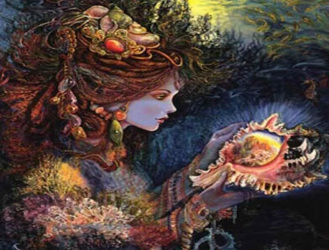 The Sea Mither The Sea Mither is the benign force of the summer sea - "mither" being the Orcadian pronunciation of "mother".
The Sea Mither The Sea Mither is the benign force of the summer sea - "mither" being the Orcadian pronunciation of "mother".The Sea Mither granted life to every living thing, bringing warmth to the oceans and calming the storms that were the sorrow of many an Orkney family.
But, as in all good tales, the forces of good must have a bitter nemesis. The Sea Mither was no exception.
She had a very powerful, and hostile, rival in Teran, the spirit of winter. Teran's screaming voice was heard in the fury of the winter gales and his anger seen in the mountainous waves that crashed against the seashore.
Each spring, around the vernal equinox, the Sea Mither returned to Orkney to take up her summer residence in the sea.
Her return always prompted the beginning of the "Vore Tullye" - the Spring Struggle - a fierce battle against Teran that lasted for weeks and manifested itself in devastating storms that churned the sea into a boiling froth.
However, the result of this conflict was always a foregone conclusion. The Sea Mither had returned, refreshed and strong, and always triumphed over her adversary.
Once overcome, Teran was bound firmly at the bottom of the sea and thus began the Sea Mither's beneficent reign. She would immediately set to work restoring the damage caused by Teran.
She stilled his violent storms and calmed the raging sea. Warmth and life returned to the water, interrupted only by the occasional squall, caused by Teran as he struggled to break his bonds.
But, as winter approached and the equinox grew near, the Sea Mither, exhausted by her labors over the summer, was forced to confront Teran
again.
Breaking free of his shackles, another battle - the "Gore Vellye" or Autumn Tumult - ensued. But this time, Teran would emerge victorious, gripping the islands once more in a terrible embrace.
His foe banished, Teran would once again reign supreme and for a while every living creature had to submit to his tyrannical rule. Nuckelavee was one of his creatures.
The Orkney folklorist, Walter Traill Dennison, lived in Sanday
in the nineteenth century. He knew an old man who was credited with having once encountered Nuckelavee, and with having made a narrow escape from the monster's clutches. This man was very reticent on the subject. However, after much higgling and persuasion, the following narrative was extracted:--
Tammas, like his namesake Tam o' Shanter, was out late one night. It was, though moonless, a fine starlit night. Tammas's road lay close by the seashore, and as he entered a part of the road that was hemmed in on one
side by the sea, and on the other by a deep fresh-water loch, he saw some huge object in front of, and moving towards him. What was he to do? He was sure it was no earthly thing that was steadily coming towards him. He could not go to either side, and to turn his back to an evil thing he had heard was the most dangerous position of all. So Tammie said to himself, "The Lord be aboot me, any tak' care o' me, as I am oot on no evil intent this night!" Tammie was always regarded as rough and foolhardy. He determined, as the best of two evils, to face the foe, and so walked resolutely yet slowly forward. He soon discovered to his horror that the gruesome creature approaching him was none other than the dreaded Nuckelavee. The lower part of this terrible monster, as seen by Tammie,
was like a great horse with flappers like fins about his legs, with a mouth as
wide as a whale's, from whence came breath like steam from a brewing-kettle. He had but one eye, and that as red as fire. On him sat, or rather seemed to grow from his back, a huge man with no legs, and arms that reached nearly to the ground. His head was as big as a clue of simmons that is a clue of straw ropes, generally about three feet in diameter, and this huge head kept rolling from one shoulder to the other as if it meant to tumble off. But, what to Tammie appeared most horrible of all, was that the monster was skinless. This utter want of skin added much to the terrific appearance of the creature's naked body. The whole surface of it showed only red raw flesh, in which Tammie saw blood, black as tar, running through yellow veins, and great white sinews, thick as horse tethers, twisting, stretching, and contracting as the monster moved. Tammie went slowly on in mortal terror, his hair on end, a cold sensation like a film of ice between his scalp and his skull, and a cold sweat bursting from every pore. He knew it was useless to flee, and he said, if he had to die, he would rather see who killed him than die with his back to the foe. In all his terror Tammie remembered what he had heard of Nuckelavee's dislike to fresh
water, and, therefore, took that side of the road nearest to the loch. The awful moment came when the lower part of the head of the monster got abreast of Tammie. The mouth of the monster yawned like a bottomless pit. Tammie found its hot breath like fire on his face: the long arms stretched out to seize the unhappy man. To avoid, if possible, the monster's clutch, Tammie swerved as near as he could to the loch. In doing
so, one of his feet went into the loch, splashing up some water on the foreleg of the monster, whereat the horse gave a snort like thunder and shied over to the other side of the road, and Tammie felt the wind of Nuckelavee's clutches as he narrowly escaped the monster's grip. Tammie saw his opportunity, and ran with all his might. Sore need had he to
run, for Nuckelavee turned and galloped after him, bellowing with a sound like the roaring of the sea. In front of Tammie lay a rivulet, through which the surplus water of the loch found its way to the sea, and Tammie knew, if he could only cross the running water, he was safe, so he strained every nerve. As he reached the near bank, another clutch was made at him by the long arms. Tammie made a desperate spring and reached the other side, leaving his bonnet in the monster's clutches. Nuckelavee gave a wild unearthly yell of disappointed rage as Tammie fell senseless--on the safe side of the water.
Now aren't you glad you visited and read my scary tale? Thanks for coming. Oh, and have a safe Samhain!
Published on October 31, 2013 10:36
October 8, 2013
The Well-Dressed Table...so, what's for dinner?
 It's autumn, a wonderful season of the year. Don't you agree? The days are getting shorter--and noticeably cooler. Leaves are changing colors and fragrant smoke from hearth fires scents the air. The harvest is over and its time for hunting and gathering--not only of food, but of people around your supper table. Are you ready for a few supper options? I certainly am! So come on in to my kitchen....
It's autumn, a wonderful season of the year. Don't you agree? The days are getting shorter--and noticeably cooler. Leaves are changing colors and fragrant smoke from hearth fires scents the air. The harvest is over and its time for hunting and gathering--not only of food, but of people around your supper table. Are you ready for a few supper options? I certainly am! So come on in to my kitchen....
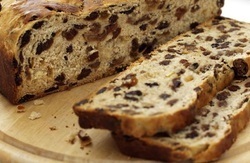 This is Barm Brack. It's great for afternoon tea. (Makes 2 loaves.)
This is Barm Brack. It's great for afternoon tea. (Makes 2 loaves.) 4-5 cups bread or all-purpose flour
1/2 c. sugar
2 tsp. salt
1 tsp. grated lemon peel
2 pkgs. dry yeast
1/2 cup butter, room temperature
3/4 c. water
2 eggs
1-1/2 c. golden raisins
1/2 c. chopped mixed candied fruit
1 tsp. sugar dissolved in 1 Tbsp. water
In a large mixing or mixer bowl, measure 1-1/2 cups flour, sugar, salt, lemon peel and yeast.
In a saucepan, combine the butter, water, and milk. Heat over a low flame until the liquid is hot (120-130 degrees Fahrenheit). Add to the dry ingredients and beat by hand with a wooden spoon, or with the mixer flat beater at medium speed for 2 minutes, scraping the bowl occasionally. Add the eggs and 3/4 c. flour, or enough to make a stiff batter. Beat vigorously by hand or at high speed in the mixer for 2 minutes.
Add flour 1/4 c. at a time, beating with the spoon and working with the hands, or in the mixer using a dough hook, to form a shaggy mass that can be lifted from the bowl and placed on the work surface.
Knead the dough by hand or on a floured work surface or in the mixer, until it is smooth and elastic, about 10 minutes. If the dough is sticky, add liberal sprinkles of flour. The dough will leave the sides of the bowl in the mixer and gather around the dough hook.
Place the dough in a greased bowl, cover tightly with plastic wrap, and leave at room temperature until the dough has risen to about twice its original size, about 45 minutes. (If prepared with fast-rising yeast and at the recommended higher temperatures, reduce the rising times by about half.)
Punch down the dough and turn onto the floured work surface. Work in the raisins and candied fruit. Divide the dough in half, shape each half into a ball, and let rest under a towel for 5 minutes.
Form each loaf by pressing a ball, under your palms or with a rolling pin, into a flat oval, roughly the length of the 8 x 4 inch loaf pan. Fold the oval in half, pinch the seam tightly to seal, tuck under the ends, and place in the loaf pan, seam side down.
Cover the dough loosely with wax paper and let rise until it has doubled in bulk, about 1 hour. The dough should be just above the edge of the loaf pan.
Preheat the oven to 375 degrees F. about 20 minutes before baking.
Bake in the moderately hot oven until the loaves test done, 35 to 40 minutes. Turn out one loaf and tap the bottom with a forefinger. A hard, hollow sound means the light golden brown loaf is done. If not done, return to the oven--without the pan, if you wish a deep brown crust--for an additional 10 minutes. Finally, brush the crusts with the sugar glaze. Return to the oven for 2-3 minutes, or until shiny.
Remove the bread from the oven. While the bread is warm, cut thick slices and serve with ample butter. This bread will keep for several days wrapped in plastic or foil. It also freezes nicely.
Now, lets pour the tea and enjoy!
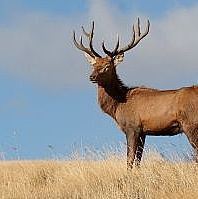 This is the noble red deer. Isn't he magnificent? His meat makes a wonderful roast. This recipe comes from a very old cookbook called, The Queen's Closet Opened, published 1655. Cool, huh? Here's the recipe.
This is the noble red deer. Isn't he magnificent? His meat makes a wonderful roast. This recipe comes from a very old cookbook called, The Queen's Closet Opened, published 1655. Cool, huh? Here's the recipe.“Take a buttock of red deer or beefe, cut it the long waies with the grain, beat it
well with a rowling pin, then broil it upon the coals, a little after it is cold, draw it through with lard, then lay in some white wine vinegar, pepper, salt, cloves, mace, and bay leaves, then let it lye three or four days, then bake it in rye past, and when it is cold fill it up with butter, after a fortnight it will be eaten”
Sounds yummy--right??? No? Hm-m. Well, then, how about this?
Roast Venison with Red Sauce
5 lb. venison roast 4 Tbsp port 1 lb. red currant jelly 1 stick cinnamon Zest of 2 lemons or oranges
Roast the venison as you would beef, to the medium-done stage (about 50 minutes—calculate roughly 10 minutes for every pound) at 350 degrees. Baste all the while.
When it is ready to serve, mix the remaining ingredients together in a
saucepan and heat thoroughly until bubbling gently.
Serve the red sauce on the side to spoon over the slices of
venison.
Okay--MUCH better....
How about dessert next?
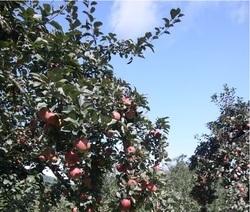 Okay! It's time to bake Apple Pie!
Okay! It's time to bake Apple Pie!(This is actually my recipe--so not to worry.)
First, let's make the crust. This recipe makes enough for two 10-inch or 9-inch deep dish pie crusts. The ingredients should be very cold before beginning. I even put the dry ingredients and the bowl I use into the freezer for an hour before beginning.
2 1/2 cups flour1 tsp. salt2 Tbsp. sugar12 Tbsp. cold (not frozen) butter, cut into small pieces8 Tbsp. frozen shortening, cut into small pieces4 Tbsp. ice water4 Tbsp. very cold vodka1 food processor--so much easier than cutting everything together by
hand
Pre-heat the oven to 425 degrees. Pulse flour mixture together. Add cut-up pieces of butter and shortening and cover with flour mixture. Using short pulses in the food processor until mixture resembles corn meal. Turn into the cold bowl and add only enough cold water/vodka mixture to incorporate into a ball. Form into a ball using fingertips only and cover with plastic wrap, then place in the refrigerator to rest while peeling, coring and slicing the apples.
When apples are sliced and in the bowl, mixed together with the sugar, flour and spices, get ready to roll out the pie crusts.
The easiest method I've ever found is one I developed myself. Tear off 4 strips of plastic wrap and put two of them together to form each of 2 large squares. Moisten the countertop or a chilled pastry marble with water and put one square down. (Moistening it helps keep the plastic wrap from sliding around while the pie crust is being rolled out.) Flour plastic wrap square well. Divide the refrigerated dough ball into two pieces and return the second piece to the refrigerator, re-wrapped in the plastic wrap.
Pat out the first half into a circle and cover with the second square of plastic wrap over the top. Roll out the pie crust into roughly a 12-inch diameter circle. Gently loosen the top square of plastic wrap, flour it, then lift the entire bundle of two plastic sheets and quickly, but gently, flip it all over. Gently lift away the top plastic sheet and lift the dough circle over the rolling pin. Very gently place it over the pie plate and fit the dough circle into it. Trim away all but about two inches of dough around the outside border of the pie plate. Roll out the top crust using the same method.
The pie apple splices will have become very limp and moist by this time--the sugar soaks the liquid out of the apples--a really cool chemical process--so they don't require pre-cooking. Gently squeeze excess liquid from the pie apples (but DO NOT discard the liquid) and place them in the bottom crust, piling them up if necessary. Cover with the top crust. Using pastry sheers, trim off any excess dough, to make the top crust the same size as the bottom crust. Fold the two dough crust edges together and very gently seal them by pinching them. Flute the borders decoratively, vent the pie by piercing the top crust in several places with a very sharp knife. You may make a decorative pattern of it, if you so choose. Protect the outer border of the fluted pie crust using strips of folded aluminum foil to prevent excessive browning.
Place the pie on the middle shelf of the oven and bake at 425 degrees (Fahrenheit) for 20 minutes. Without opening the oven door, lower the oven temperature to 375 degrees and continue baking for 50 minutes. When the pie is nicely browned, remove it from the oven and place it on a rack to cool at least two hours before serving.
Here's the next part of the process--the pie apples themselves. You'll need at least 6 large Granny Smith apples or a mixture of any tart pie apples. If the apples are small, you'll need at least 8 of them. Peel, core and slice them into the cleaned bowl you've mixed up the pie dough in. Next, whisk together:
3 Tbsp. cornstarch1 cup sugar1 tsp.
cinnamon1/4 tsp. cloves1/4 tsp. freshly ground nutmeg
Cover the pie apple slices with this mixture and gently mix it into the pie apple slices to coat each one. Let this mixture sit for at least 30 minutes while making the dough crusts. When ready, they will be limp and a lot of liquid will have formed in the bottom of the bowl. The pie apple slices will need to be gently squeezed out before placing into the bottom crust. Do not discard the liquid, as mentioned above.
After the apple slices have all been placed into the pie crust, but BEFORE the top crust has been added, mix the liquid together with two gently beaten egg yolks and 1/2 cup heavy cream. Slowly pour over the pie apple slices in the pie plate and cover with the top crust. Bake, cool and slice the cooled pie. Stand by. You'll never, ever taste anything more delightful.
Can you think of a single different way to make better use of nature's autumn bounty? Sorry--my mouth is too full of apple pie to answer my rhetorical question--munch, munch, munch....
Published on October 08, 2013 08:03
August 13, 2013
The People in Alexandra's life
 The first man in Alexandra's life was, of course, her father, Lord Edward Campbell. Lord Edward adored his little daughter and his beautiful wife, Georgiana. Alexandra's mother surrendered her life when Alexandra was not quite three years old, however, and for years, Lord Edward was unable to look at Alexandra without recalling the loss of his wife. On his way to her wedding, Lord Edward told her she had only to look in a mirror to know what her mother looked like. We shall not know, yet, what Alexandra looks like--that we won't know until the cover comes out on Richard Berkeley's Bride. This is precisely the same problem we face with Richard. We won't know this until the cover goddess works her wonderful magic.
The first man in Alexandra's life was, of course, her father, Lord Edward Campbell. Lord Edward adored his little daughter and his beautiful wife, Georgiana. Alexandra's mother surrendered her life when Alexandra was not quite three years old, however, and for years, Lord Edward was unable to look at Alexandra without recalling the loss of his wife. On his way to her wedding, Lord Edward told her she had only to look in a mirror to know what her mother looked like. We shall not know, yet, what Alexandra looks like--that we won't know until the cover comes out on Richard Berkeley's Bride. This is precisely the same problem we face with Richard. We won't know this until the cover goddess works her wonderful magic.There are a number of people Alexandra is very familiar with, however, and whose pictures are available to us to see. First is her beloved grandfather, Lord John Campbell, the fourth Duke of Argyll. Take a look at this imposing man.
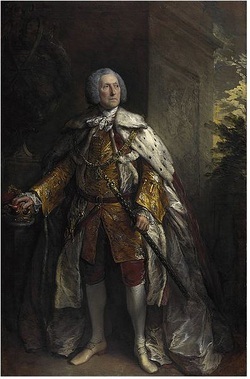 Lord John Campbell, the 4th Duke of Argyll This is His Grace of Argyll in his ducal robes. In his younger years he'd served King George II as a general in the British Army. He married Lady Mary Bellenden and together they brought a daughter, Caroline and five sons into the world--a sixth, if you count the fictional son I gave him, Lord Edward Campbell. No matter who or what he was, he was Alexandra's beloved grandfather, a man whose memory she cherished all her life.
Lord John Campbell, the 4th Duke of Argyll This is His Grace of Argyll in his ducal robes. In his younger years he'd served King George II as a general in the British Army. He married Lady Mary Bellenden and together they brought a daughter, Caroline and five sons into the world--a sixth, if you count the fictional son I gave him, Lord Edward Campbell. No matter who or what he was, he was Alexandra's beloved grandfather, a man whose memory she cherished all her life.
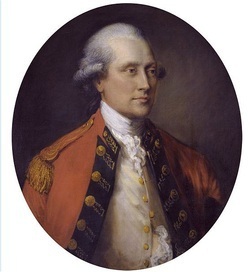 Lord John Campbell, the 5th Duke of Argyll This is Lord John Campbell, the fifth Duke of Argyll, Alexandra's favorite uncle.
Lord John Campbell, the 5th Duke of Argyll This is Lord John Campbell, the fifth Duke of Argyll, Alexandra's favorite uncle.Lord John married Elizabeth, the Duchess of Hamilton. After her husband, John ascended to his title of Duke of Argyll, Duchess Elizabeth was known as the double duchess. She had the distinction of being the mother of four duke, two Dukes of Hamilton and two Dukes of Argyll. She was also known as one of the most beautiful women in England.
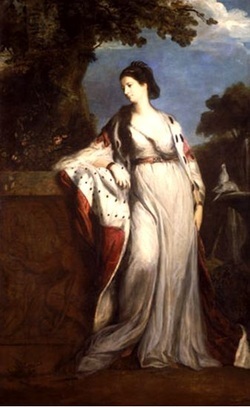 Elizabeth, the Duchess of Hamilton and Argyll This is a picture of Duchess Elizabeth in her Hamilton ducal robes. She gave the Duke of Hamilton three children before his death, Elizabeth (or Betty), James, who succeeded his father as the 7th Duke of Hamilton and Douglas, who succeeded his brother as the 8th Duke. After her marriage to Lt. General John Campbell, she gave him five more children: Lord George John, who died in infancy, Lady Augusta, Lord George William, who became the 6th Duke of Argyll, Charlotte and Lord John Douglas Edward, who became the 7th Duke of Argyll. Whew!
Elizabeth, the Duchess of Hamilton and Argyll This is a picture of Duchess Elizabeth in her Hamilton ducal robes. She gave the Duke of Hamilton three children before his death, Elizabeth (or Betty), James, who succeeded his father as the 7th Duke of Hamilton and Douglas, who succeeded his brother as the 8th Duke. After her marriage to Lt. General John Campbell, she gave him five more children: Lord George John, who died in infancy, Lady Augusta, Lord George William, who became the 6th Duke of Argyll, Charlotte and Lord John Douglas Edward, who became the 7th Duke of Argyll. Whew!
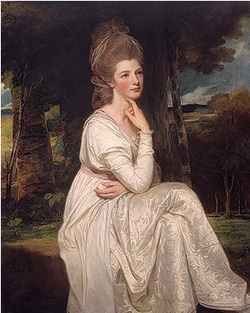 Lady Elizabeth Hamilton This is a picture of Alexandra's favorite cousin, Elizabeth--or Betty. She'll be met in the last chapter of Richard Berkeley's Bride. In her youth, Betty had an insouciant personality. All that changed after her mother more or less forced her into a marriage with Edward Smith-Stanley, the 12th Earl of Derby, an extremely wealthy man. The problem was that, although she was the only daughter of a duke, her mother had spent her entire dowry in a vain attempt to save her brother James's dukedom from the grasping claws of the Duchess of Douglas. To further complicate matters, Betty had already lost her heart to John Frederick Sackville who became the 3rd Duke of Dorset. Betty, always an irrepressible girl, maintained a giddy whirl of social events during the brief years of her marriage (and the tiresome but necessary pursuit of attempting to provide her husband with the necessary heir and his spare). Eventually, she left her husband and children to run to the waiting arms of the Duke of Dorset. Unfortunately, once he had her, he was less eager to marry her. Poor Betty discovered what many another before her had learned--that a lady may commit any indiscretion, as long as it remains a private matter. Once the papers of the day learned her story, Queen Charlotte also never again admitted her to court. Neither did a lot of other hostesses of the day. Poor Betty died a sad and lonely woman at the age of 44.
Lady Elizabeth Hamilton This is a picture of Alexandra's favorite cousin, Elizabeth--or Betty. She'll be met in the last chapter of Richard Berkeley's Bride. In her youth, Betty had an insouciant personality. All that changed after her mother more or less forced her into a marriage with Edward Smith-Stanley, the 12th Earl of Derby, an extremely wealthy man. The problem was that, although she was the only daughter of a duke, her mother had spent her entire dowry in a vain attempt to save her brother James's dukedom from the grasping claws of the Duchess of Douglas. To further complicate matters, Betty had already lost her heart to John Frederick Sackville who became the 3rd Duke of Dorset. Betty, always an irrepressible girl, maintained a giddy whirl of social events during the brief years of her marriage (and the tiresome but necessary pursuit of attempting to provide her husband with the necessary heir and his spare). Eventually, she left her husband and children to run to the waiting arms of the Duke of Dorset. Unfortunately, once he had her, he was less eager to marry her. Poor Betty discovered what many another before her had learned--that a lady may commit any indiscretion, as long as it remains a private matter. Once the papers of the day learned her story, Queen Charlotte also never again admitted her to court. Neither did a lot of other hostesses of the day. Poor Betty died a sad and lonely woman at the age of 44.
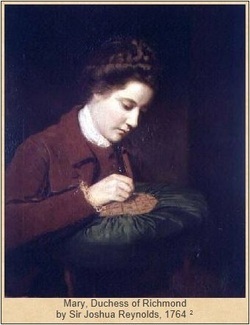 This is Mary, who became the Duchess of Richmond and Lennox after her marriage. She is another of Alexandra's cousins. A bit of scandal attended her birth. She was born before 1736--but her mother wasn't married to Thomas Bruce, her father, until 3 years later. Happily, Lord Thomas Bruce succeeded his father as 4th Earl of Elgin. Her mother, Caroline was not a favorite aunt of Alexandra's--nor was Mary a favorite cousin.
This is Mary, who became the Duchess of Richmond and Lennox after her marriage. She is another of Alexandra's cousins. A bit of scandal attended her birth. She was born before 1736--but her mother wasn't married to Thomas Bruce, her father, until 3 years later. Happily, Lord Thomas Bruce succeeded his father as 4th Earl of Elgin. Her mother, Caroline was not a favorite aunt of Alexandra's--nor was Mary a favorite cousin.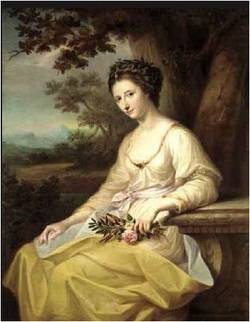 Ann Damer, nee Seymour-Conway This is Ann Seymour-Damer. She is Mary's much younger sister. Ann was born in 1748 and married a man, John Damer, who stood to inherit an earldom one day. He never made it--committed suicide well before that time. He was a fop...a well-known one...who gambled away a fortune. Ann took a house near her cousin, Horace Walpole and lived there for the remainder of her life.
Ann Damer, nee Seymour-Conway This is Ann Seymour-Damer. She is Mary's much younger sister. Ann was born in 1748 and married a man, John Damer, who stood to inherit an earldom one day. He never made it--committed suicide well before that time. He was a fop...a well-known one...who gambled away a fortune. Ann took a house near her cousin, Horace Walpole and lived there for the remainder of her life.
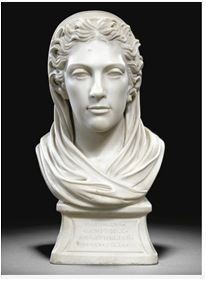 A bust of Caroline Campbell, Lady Ailesbury This is a marble bust of Ann's mother, Caroline, Lady Ailesbury. Caroline was a child of fourteen years old when her daughter, Mary was conceived. When she married Lord Thomas Bruce, in 1739, she was eighteen years of age and was known as a beauty. It is apparent that she must have been. This sculpture was created by her daughter, Ann, who became a famous sculptress in her later years. Lady Ailesbury won't be met until Dreams Within Dreams is released, in May, 2014.
A bust of Caroline Campbell, Lady Ailesbury This is a marble bust of Ann's mother, Caroline, Lady Ailesbury. Caroline was a child of fourteen years old when her daughter, Mary was conceived. When she married Lord Thomas Bruce, in 1739, she was eighteen years of age and was known as a beauty. It is apparent that she must have been. This sculpture was created by her daughter, Ann, who became a famous sculptress in her later years. Lady Ailesbury won't be met until Dreams Within Dreams is released, in May, 2014.
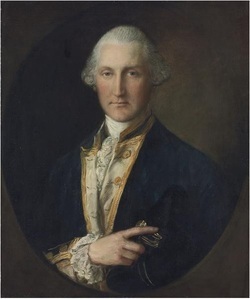 Lord William Campbell This is Lord William Campbell who bore the distinction of being the last Royal Governor of South Carolina before the Revolutionary War. After sending his wife and children to safety outside Charleston, he escaped the city on a small boat that came up a branch of Vanderhorst’s Creek to the back of his garden.
Lord William Campbell This is Lord William Campbell who bore the distinction of being the last Royal Governor of South Carolina before the Revolutionary War. After sending his wife and children to safety outside Charleston, he escaped the city on a small boat that came up a branch of Vanderhorst’s Creek to the back of his garden.Afterward, he went aboard the British warship Tamar and joined up with Sir Peter Parker, a British admiral in Cape Fear. Lord William was wounded during the First Battle of Charleston, 28 June, 1776 while aboard Sir Peter Parker's flagship, HMS Bristol. He returned to London to recover from his wound and rejoined his wife and children. Lord William married a wealthy
and very pretty lady from Charleston, Sarah Izard during his first visit to Charleston in April, 1763. A painting of her exists by Nathaniel Hone. Their children were William and Louisa Anne. Lord William never fully recovered from the effects of his wound and died in England two years later, on 5 September, 1778. As it happened, he died within days of his brother Edward who had been wounded in the same battle.
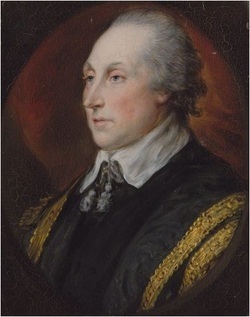 Lord Frederick Campbell This is Lord Frederick Campbell, the youngest of Alexandra's youngest uncle. Lord Frederick is met in Dreams Within Dreams where he protests Richard's appointment as his brother Edward's executor.
Lord Frederick Campbell This is Lord Frederick Campbell, the youngest of Alexandra's youngest uncle. Lord Frederick is met in Dreams Within Dreams where he protests Richard's appointment as his brother Edward's executor.I hope you have enjoyed a brief glimpse at Alexandra's illustrious family. Other than Lord Edward, her husband Richard and herself, these people really lived.
Published on August 13, 2013 08:54
September 27, 2012
The Well Dressed Lady of 1776
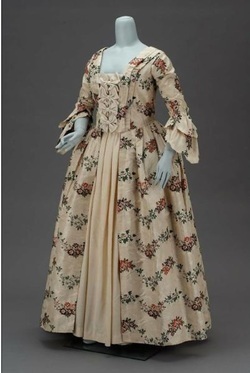 What would the well dressed lady wear in 1776?
What would the well dressed lady wear in 1776? I'm back today to show you some of the gowns Alexandra and her friends might wear.
She would likely start her day with something like this handpainted silk. Isn't it pretty? The ruffles on the sleeves are only pinned in place so her lady's maid may easily replace them with fine lace ruffles if Alexandra chooses. She often does.
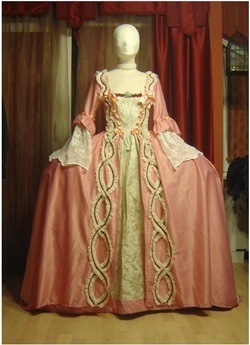 Here is a gown Alexandra might change into for dinner. The skirt is longer and forms a short train in the back. The hoops which hold it out on each side are called panniers. She might put her handkerchief into her pocket that's worn beneath her petticoat. She would get to it through well-concealed slits in a seam of her skirts.
Here is a gown Alexandra might change into for dinner. The skirt is longer and forms a short train in the back. The hoops which hold it out on each side are called panniers. She might put her handkerchief into her pocket that's worn beneath her petticoat. She would get to it through well-concealed slits in a seam of her skirts. 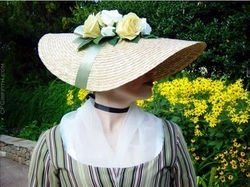 I adore this pretty staw hat Alexandra might have worn during her walks in her garden.
I adore this pretty staw hat Alexandra might have worn during her walks in her garden.
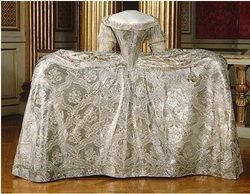 This fabulous gown made of cloth of silver is what Alexandra wore for her wedding. She wore her gown with a stiff stomacher heavily embroidered in shades of blue on white silk. The bodice of her gown was pinned to the stomacher on each side. The sack back of her dress formed a court train. The train could be looped up and secured to the back of her gown by buttons cleverly concealed in the fabric. This made dancing at her wedding ball easier. Afterward, the very next opportunity she had to wear her gown was to the Queen's Drawing Room, held every Tuesday and Thursday afternoons at St. James Palace. This was a command performance where she would have been presented to the queen, along with her brand new husband. This was expected of all newly married matrons in St. James District. In Alexandra's case, she had been married over a year before making her curtsey to Queen Charlotte at a Drawing Room. Read the first chapter of Dreams Within Dreams here on my website.
This fabulous gown made of cloth of silver is what Alexandra wore for her wedding. She wore her gown with a stiff stomacher heavily embroidered in shades of blue on white silk. The bodice of her gown was pinned to the stomacher on each side. The sack back of her dress formed a court train. The train could be looped up and secured to the back of her gown by buttons cleverly concealed in the fabric. This made dancing at her wedding ball easier. Afterward, the very next opportunity she had to wear her gown was to the Queen's Drawing Room, held every Tuesday and Thursday afternoons at St. James Palace. This was a command performance where she would have been presented to the queen, along with her brand new husband. This was expected of all newly married matrons in St. James District. In Alexandra's case, she had been married over a year before making her curtsey to Queen Charlotte at a Drawing Room. Read the first chapter of Dreams Within Dreams here on my website.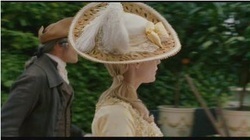 What can I say? Alexandra and her friends love hats. This girl wears them well, don't you agree?
What can I say? Alexandra and her friends love hats. This girl wears them well, don't you agree?
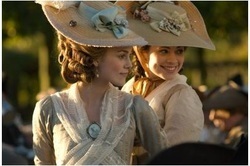 Here are two more ladies wearing a different style hat. This style allows for their high-piled curls. Simply lovely!
Here are two more ladies wearing a different style hat. This style allows for their high-piled curls. Simply lovely!
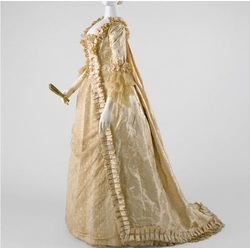 Here's another lovely evening dress. Alexandra might have worn such a gown to dinner or an evening entertainment.
Here's another lovely evening dress. Alexandra might have worn such a gown to dinner or an evening entertainment.
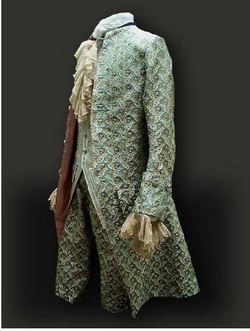 No, of course Alexandra wouldn't have worn this elegant gentleman's suit of clothing--but Richard might have chosen to wear it for dinner and evening entertainments. Even conservative gentlemen wore lace on their shirt cuffs sometimes!
No, of course Alexandra wouldn't have worn this elegant gentleman's suit of clothing--but Richard might have chosen to wear it for dinner and evening entertainments. Even conservative gentlemen wore lace on their shirt cuffs sometimes!Would you like to see a picture or two of Oakhurst? Of course you would!
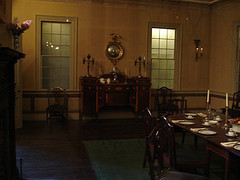 Here is the dining room. The table holds twenty people for an intimate dining experience.
Here is the dining room. The table holds twenty people for an intimate dining experience.
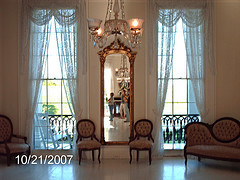 Here is the small sitting room. Alexandra's pedal harpsichord sits at the other end of the room.
Here is the small sitting room. Alexandra's pedal harpsichord sits at the other end of the room. 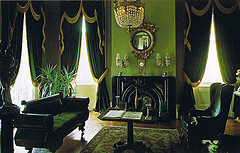 This is Richard's study. It seems a cozy place to do the plantation's business. Does it not?
This is Richard's study. It seems a cozy place to do the plantation's business. Does it not?I hope you'll join Richard, Alexandra and me again soon. And thank you for coming. I've enjoyed your visit.
Published on September 27, 2012 06:58
September 12, 2012
Autumn in Inveraray, September 12th, 2012
I added a picture of Inveraray Castle to the blog heading. Even in autumn, the castle is beautiful, isn't it?
It is the home of the Duke and Duchess of Argyll and their children. The castle was designed by Sir John Vanbrugh for the great second duke in 1720. Construction began in 1746. The fifth duke saw the castle's completion in 1789. The castellated towers were part of the original building but it was considered less impressive than the original castle once located on the same site--more a mansion than a castle--so the conical towers were added later to give it a more "castle-like" appearance.
As I mentioned, an original castle once stood on the same site, built by the Campbell Earls of Argyll during the 15th century. It was eventually destroyed by fire during the Civil War of 1644 by the Marquis of Montrose.
My novels are partially set in this beautiful place. There's a lot more to tell you about it but I thought you might enjoy a picture tour instead.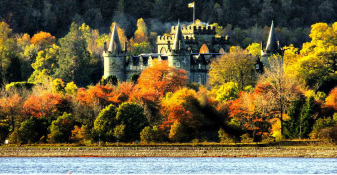 Here is the entire view of the picture at the top. The water you see? It's Loch Fyne.
Here is the entire view of the picture at the top. The water you see? It's Loch Fyne.
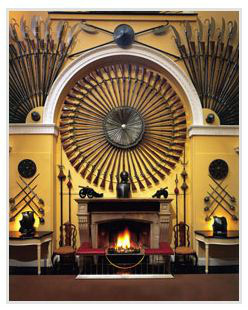 This is Armoury Hall. It is located centrally, in the Great Hall. It's ceiling soars to 21 meters (that's over 68 feet high to we metrically-challenged Americans). It's the highest ceiling in Scotland. In case you wondered, this spandrel of muskets on the wall and surrounded by Lochaber axes is one of several located in this room.
This is Armoury Hall. It is located centrally, in the Great Hall. It's ceiling soars to 21 meters (that's over 68 feet high to we metrically-challenged Americans). It's the highest ceiling in Scotland. In case you wondered, this spandrel of muskets on the wall and surrounded by Lochaber axes is one of several located in this room.
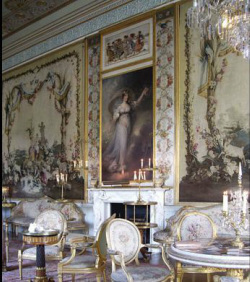 This is the Tapestry Drawing Room. It is decorated in the Parisian style more popular during the 18th century. The painting over the fireplace is of Lady Charlotte Campbell as "Aurora" painted by
This is the Tapestry Drawing Room. It is decorated in the Parisian style more popular during the 18th century. The painting over the fireplace is of Lady Charlotte Campbell as "Aurora" painted by
John Hoppner.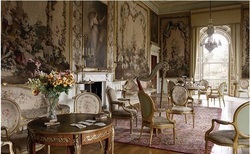 Here is another view of the same room.
Here is another view of the same room. 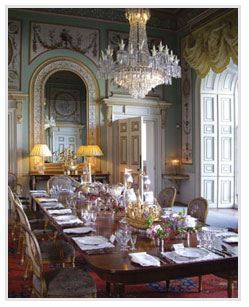 This is the State Dining Room. The colors in the room usually amaze visitors. The dining table dates from around 1800. The Waterford chandelier is the largest of three in the castle. The other two are in the Tapestry Drawing Room
This is the State Dining Room. The colors in the room usually amaze visitors. The dining table dates from around 1800. The Waterford chandelier is the largest of three in the castle. The other two are in the Tapestry Drawing Room
It is the home of the Duke and Duchess of Argyll and their children. The castle was designed by Sir John Vanbrugh for the great second duke in 1720. Construction began in 1746. The fifth duke saw the castle's completion in 1789. The castellated towers were part of the original building but it was considered less impressive than the original castle once located on the same site--more a mansion than a castle--so the conical towers were added later to give it a more "castle-like" appearance.
As I mentioned, an original castle once stood on the same site, built by the Campbell Earls of Argyll during the 15th century. It was eventually destroyed by fire during the Civil War of 1644 by the Marquis of Montrose.
My novels are partially set in this beautiful place. There's a lot more to tell you about it but I thought you might enjoy a picture tour instead.
 Here is the entire view of the picture at the top. The water you see? It's Loch Fyne.
Here is the entire view of the picture at the top. The water you see? It's Loch Fyne.
 This is Armoury Hall. It is located centrally, in the Great Hall. It's ceiling soars to 21 meters (that's over 68 feet high to we metrically-challenged Americans). It's the highest ceiling in Scotland. In case you wondered, this spandrel of muskets on the wall and surrounded by Lochaber axes is one of several located in this room.
This is Armoury Hall. It is located centrally, in the Great Hall. It's ceiling soars to 21 meters (that's over 68 feet high to we metrically-challenged Americans). It's the highest ceiling in Scotland. In case you wondered, this spandrel of muskets on the wall and surrounded by Lochaber axes is one of several located in this room.
 This is the Tapestry Drawing Room. It is decorated in the Parisian style more popular during the 18th century. The painting over the fireplace is of Lady Charlotte Campbell as "Aurora" painted by
This is the Tapestry Drawing Room. It is decorated in the Parisian style more popular during the 18th century. The painting over the fireplace is of Lady Charlotte Campbell as "Aurora" painted byJohn Hoppner.
 Here is another view of the same room.
Here is another view of the same room.  This is the State Dining Room. The colors in the room usually amaze visitors. The dining table dates from around 1800. The Waterford chandelier is the largest of three in the castle. The other two are in the Tapestry Drawing Room
This is the State Dining Room. The colors in the room usually amaze visitors. The dining table dates from around 1800. The Waterford chandelier is the largest of three in the castle. The other two are in the Tapestry Drawing Room
Published on September 12, 2012 09:19



